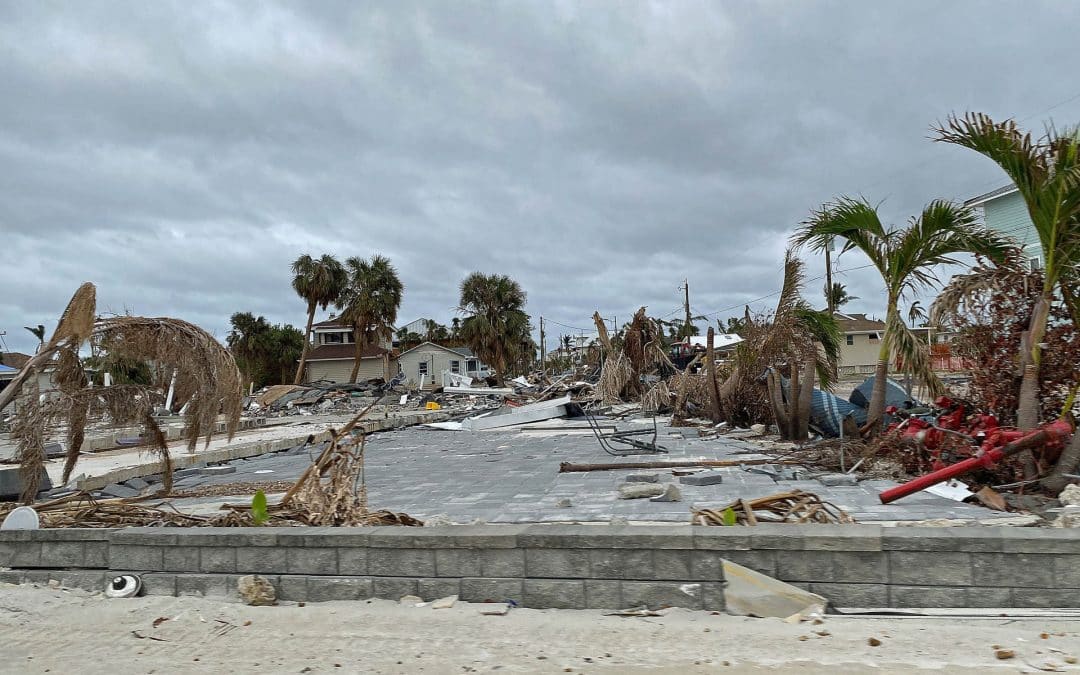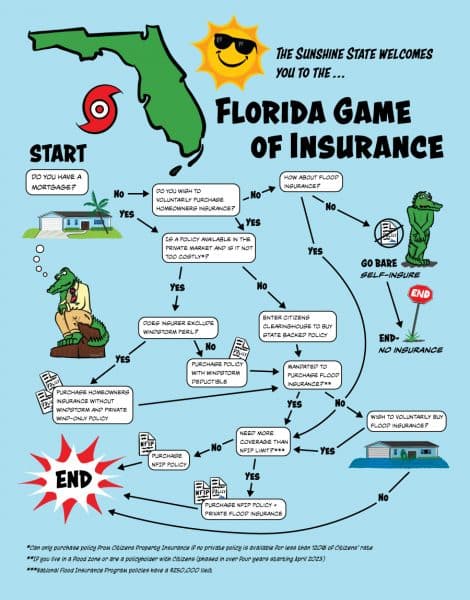An Island unto Itself
Florida’s shaky residential property insurance market stands alone.
Florida stands apart in many ways. The peninsula has the longest coastline in the contiguous United States, the world’s largest amusement park and one of the biggest wetlands anywhere.
But Florida exceptionalism cuts both ways: The state has also the costliest and arguably most troubled residential property insurance market in the United States. Here are three ways Florida’s home-insurance business is a mess.
- Average annual home-insurance premiums more than doubled the past three years to $4,231 — the highest in the nation and nearly triple the U.S. average.
- Despite the high premiums, six insurance companies were declared insolvent by regulators in 2022, all before the Category 4 Hurricane Ian ravaged Southwest Florida on Sept. 28. Ravaged by billions of dollars in annual losses in recent years, some insurers stopped writing new policies or abandoned the state, blaming losses on storms and high litigation and operating costs.
- The state-owned Citizens Property Insurance Corp. has emerged as Florida’s No. 1 home-insurance firm because increasingly it is the only insurer that will provide a homeowner a policy, or the only one they can afford. At yearend, the portfolio of the state’s “insurer of last resort” swelled to nearly 1.2 million policies, 15% of the overall Florida market, and its mounting property risk represents an exposure of $360 billion, a liability that is ultimately backed by state taxpayers.
John Rollins (MA economics ‘97), who was Citizens’ chief risk officer 2013-2017, likens the industry’s worsening condition to a pet hamster trying to keep up with an ever faster spinning wheel. “Eventually the hamster dies. And that’s where we are in the Florida insurance market now.”
Who knew insurance – customarily a mundane necessity of everyday life — could be so dramatic?
Responding to political pressure and fears the insurance crisis could harm the real estate market, legislators met in two special sessions in 2022 to take a stab at fixing problems. They changed laws to try to limit excessive lawsuits, which insurers blame lawyers and contractors for costing the industry billions of dollars in frivolous lawsuits. Lawmakers also created special funds totaling $3 billion to provide another layer of reinsurance — the essential backstop Florida’s mostly thinly capitalized insurers need to stay in business; limited the time policyholders must file claims; and chiseled away the market competitiveness of Citizens in hopes of reining in its growing policy count.
The Legislature remains largely powerless over the most obvious problem that makes the peninsula a risky place for insurers who must roll the dice every year — it is the state at the most risk for hurricanes. The trillions of dollars of ever-more valuable property crowded along Florida’s far-reaching coastline represent the largest insured loss potential in the world, according to risk modelers.
But despite the ever-present danger of hurricanes, the latest crisis appears more to do with the other factors — plus perhaps the unintended consequences of past government actions and its regulatory framework — to make Florida’s market ever-more brittle, according to many long-time participants and experts of the Florida home-insurance business.
Historic hurricanes
The legislative reforms were the most far-reaching since two other periods of insurance market turmoil in Florida history: in 1992 after the powerful Hurricane Andrew pummeled South Florida, causing $15 billion in insured losses, and in 2004 and 2005 when eight hurricanes pounded the state, collectively causing damages that surpassed those from Andrew. As a result, the nation’s major property insurers — such as Allstate and State Farm — have wanted less and less to do with Florida when it comes to insuring homes, especially along the coast. To fill the void, Florida placed temporary moratoriums on rate hikes and provided incentives to encourage a new breed of smallish Florida-based insurance companies that most people have never heard of.
Florida dodged a bullet for the next decade when no hurricanes made landfall, which was unprecedented. But the good times ended in 2017 when Hurricane Irma entered southern Florida and swept north, affecting all 67 counties and causing tens of billions of dollars in damage. Irma was followed by 2018’s Michael, only the fourth Category 5 hurricane in modern times to hit the United States — and third to hit Florida — which virtually wiped away Mexico Beach and crushed parts of the Panhandle. Concurrently, what one insurance lobbyist referred to as an “entrepreneurial cottage industry” of lawyers began exploiting legal loopholes to win major damage awards. Insurers were caught blindsided and didn’t fully account for excess litigation, which became a financial tsunami as big as a real major storm.
Litigation matters
The amount of property insurance litigation in Florida has soared ever since, according to data from the Florida Office of Insurance Regulation and the National Association of Insurance Commissioners. Florida’s U.S. share of all home-insurance lawsuits filed was 76% in 2021, yet Florida policyholders submitted only 7% of U.S. claims. Florida insurers spent $3.1 billion to defend against lawsuits, costs that are eventually passed to homeowners in higher premiums.
How’d it happen? Florida’s expanding legion of plaintiff attorneys, who on TV and radio tout lucrative awards they’ve won for clients, have become more prolific in litigating property disputes. Such suits often start after a home suffers some unexpected damage, not only from hurricanes but a growing number of convective storms. Unlike most states in which each side usually pays for their own lawyers, Florida law has allowed lawyers to reap legal expenses from insurance companies if they receive a jury award that is just $1 more than an insurers’ final settlement offer. Yet if they lose they aren’t obligated to pay the insurer’s legal costs. The law was put in place to give a slingshot to David to fight Goliath and discourage insurance companies from dragging their feet on policyholder claims. But insurers and other critics say the law resulted in tens of thousands of often questionable cases. Insurers haven’t been able to raise rates fast enough to catch up with the faster-spinning hamster wheel, Rollins said.
Meanwhile, reinsurance companies that essentially provide insurance to Florida insurers — many of which are largely unregulated — aren’t happy that they remain on the hook to pay for legal and repair and other costs that keep rising many years after storms have passed. They jacked up their rates in 2022 and continue to do so in 2023.
To stabilize the market, lawmakers largely gave insurers what they’ve been wanting for years: curtailing the incentive for lawyers to file lawsuits, with the most consequential change by erasing Florida’s one-way attorney fees. Separately, lawmakers made changes to puncture Citizens’ ballooning policy count, including incrementally mandating all Citizens policyholders carry flood insurance, which could cost some homeowners thousands of dollars a year.
Lawyers, consumer advocates and a minority of state lawmakers expressed concern that the balance has now swung too far against consumers. Amy Bach, an attorney and executive director of United Policyholders, a nonprofit that advocates for the rights of insurance customers, said, “I’m not naive enough to say that all those lawsuits are justified. But from my experience, most people after they get hit by a disaster don’t want to get involved in a lawsuit. They just want their house repaired.”
As ever with Florida property insurance, how things shake out is anybody’s guess, but one thing clear is policyholders shouldn’t expect lower premiums anytime soon. It will take a couple years to see how effective the reforms are and see any change in the market, experts said. In the meantime, it is worth considering that things could always be worse. Last summer’s Ian, one of the most powerful hurricanes ever to hit Florida, wasn’t the Big One that the industry has long feared. Had Ian not veered to the Fort Myers area but instead hit Tampa Bay — as it was initially projected — estimated insured losses would have topped $100 billion.
Robert Jerry, former dean of the University of Florida and author of the college textbook “Understanding Insurance Law,” summed it all up. “We’re living in a risky state. As Floridians, we are going to pay more for insurance. There’s no two ways about it.”





